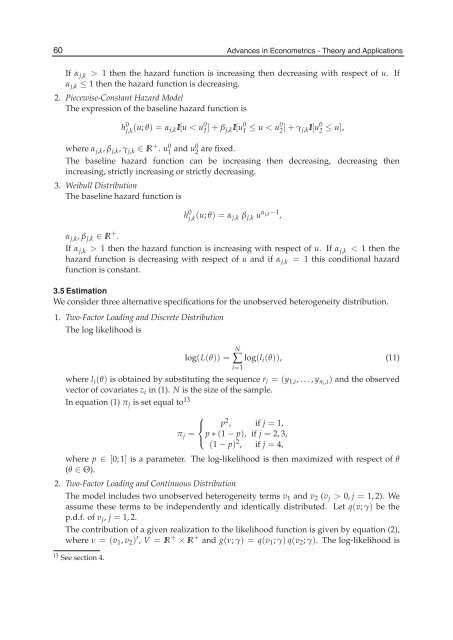The Limits of Mathematics and NP Estimation in ... - Chichilnisky
The Limits of Mathematics and NP Estimation in ... - Chichilnisky
The Limits of Mathematics and NP Estimation in ... - Chichilnisky
- No tags were found...
Create successful ePaper yourself
Turn your PDF publications into a flip-book with our unique Google optimized e-Paper software.
60 Advances <strong>in</strong> Econometrics - <strong>The</strong>ory <strong>and</strong> Applications14 Will-be-set-by-IN-TECHIf α j,k > 1 then the hazard function is <strong>in</strong>creas<strong>in</strong>g then decreas<strong>in</strong>g with respect <strong>of</strong> u. Ifα j,k ≤ 1 then the hazard function is decreas<strong>in</strong>g.2. Piecewise-Constant Hazard Model<strong>The</strong> expression <strong>of</strong> the basel<strong>in</strong>e hazard function ish 0 j,k (u; θ) =α j,k1I[u < u 0 1 ]+β j,k1I[u 0 1 ≤ u < u0 2 ]+γ j,k1I[u 0 2 ≤ u],where α j,k , β j,k , γ j,k ∈ IR + . u 0 1 <strong>and</strong> u0 2 are fixed.<strong>The</strong> basel<strong>in</strong>e hazard function can be <strong>in</strong>creas<strong>in</strong>g then decreas<strong>in</strong>g,<strong>in</strong>creas<strong>in</strong>g, strictly <strong>in</strong>creas<strong>in</strong>g or strictly decreas<strong>in</strong>g.3. Weibull Distribution<strong>The</strong> basel<strong>in</strong>e hazard function isdecreas<strong>in</strong>g thenh 0 j,k (u; θ) =α j,k β j,k u α j,k−1 ,α j,k , β j,k ∈ IR + .If α j,k > 1 then the hazard function is <strong>in</strong>creas<strong>in</strong>g with respect <strong>of</strong> u. If α j,k < 1 then thehazard function is decreas<strong>in</strong>g with respect <strong>of</strong> u <strong>and</strong> if α j,k = 1 this conditional hazardfunction is constant.3.5 <strong>Estimation</strong>We consider three alternative specifications for the unobserved heterogeneity distribution.1. Two-Factor Load<strong>in</strong>g <strong>and</strong> Discrete Distribution<strong>The</strong> log likelihood isNlog(L(θ)) = ∑ log(l i (θ)), (11)i=1where l i (θ) is obta<strong>in</strong>ed by substitut<strong>in</strong>g the sequence r i =(y 1,i ,...,y ni ,i) <strong>and</strong> the observedvector <strong>of</strong> covariates z i <strong>in</strong> (1). N is the size <strong>of</strong> the sample.In equation (1) π j is set equal to 13⎧⎨ p 2 , if j = 1,π j = p ∗ (1 − p), if j = 2, 3,⎩(1 − p) 2 , if j = 4,where p ∈ [0; 1] is a parameter. <strong>The</strong> log-likelihood is then maximized with respect <strong>of</strong> θ(θ ∈ Θ).2. Two-Factor Load<strong>in</strong>g <strong>and</strong> Cont<strong>in</strong>uous Distribution<strong>The</strong> model <strong>in</strong>cludes two unobserved heterogeneity terms v 1 <strong>and</strong> v 2 (v j > 0, j = 1, 2). Weassume these terms to be <strong>in</strong>dependently <strong>and</strong> identically distributed. Let q(v; γ) be thep.d.f. <strong>of</strong> v j , j = 1, 2.<strong>The</strong> contribution <strong>of</strong> a given realization to the likelihood function is given by equation (2),where ν =(v 1 , v 2 ) ′ , V = IR + × IR + <strong>and</strong> g(ν; γ) =q(v 1 ; γ) q(v 2 ; γ). <strong>The</strong> log-likelihood is13 See section 4.








